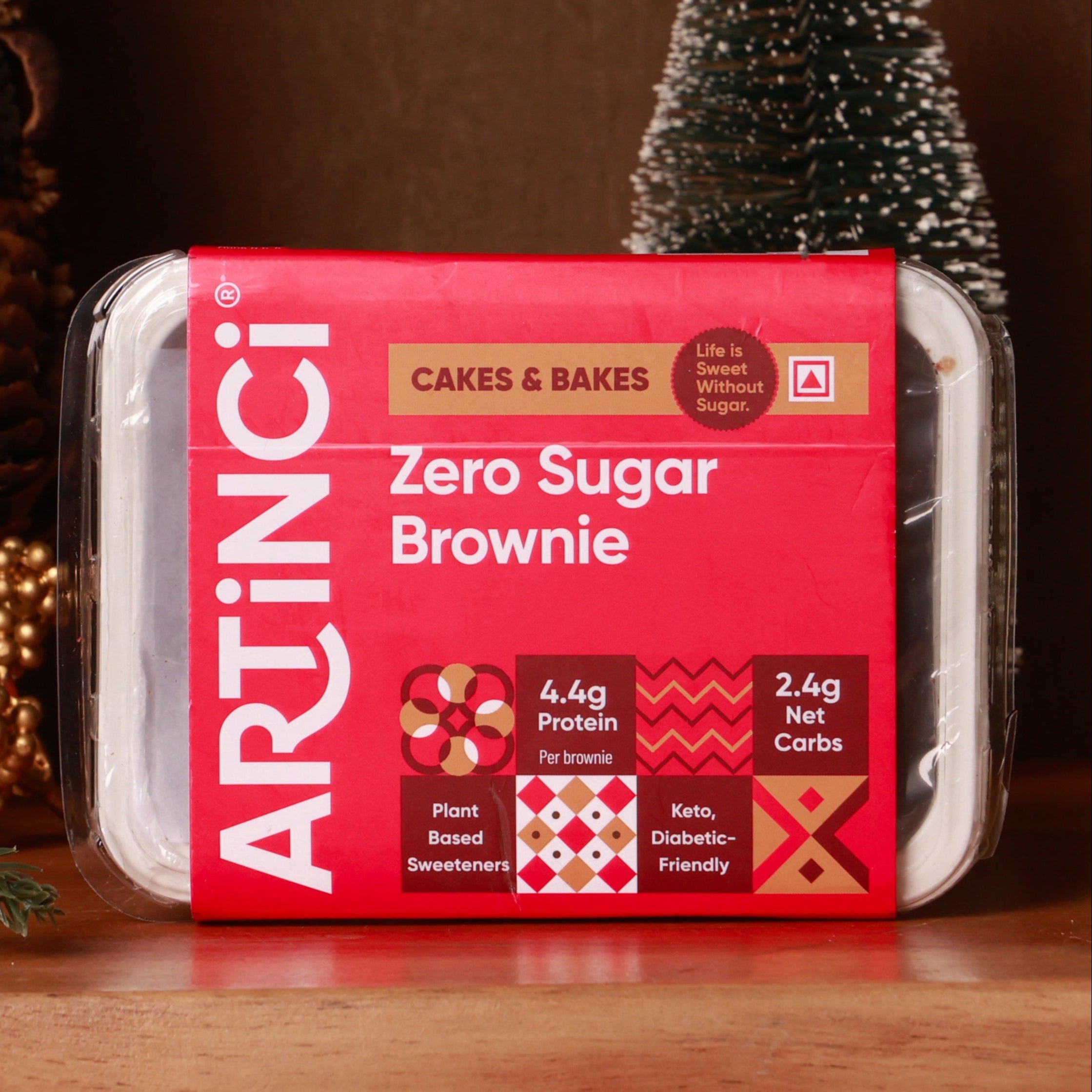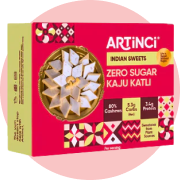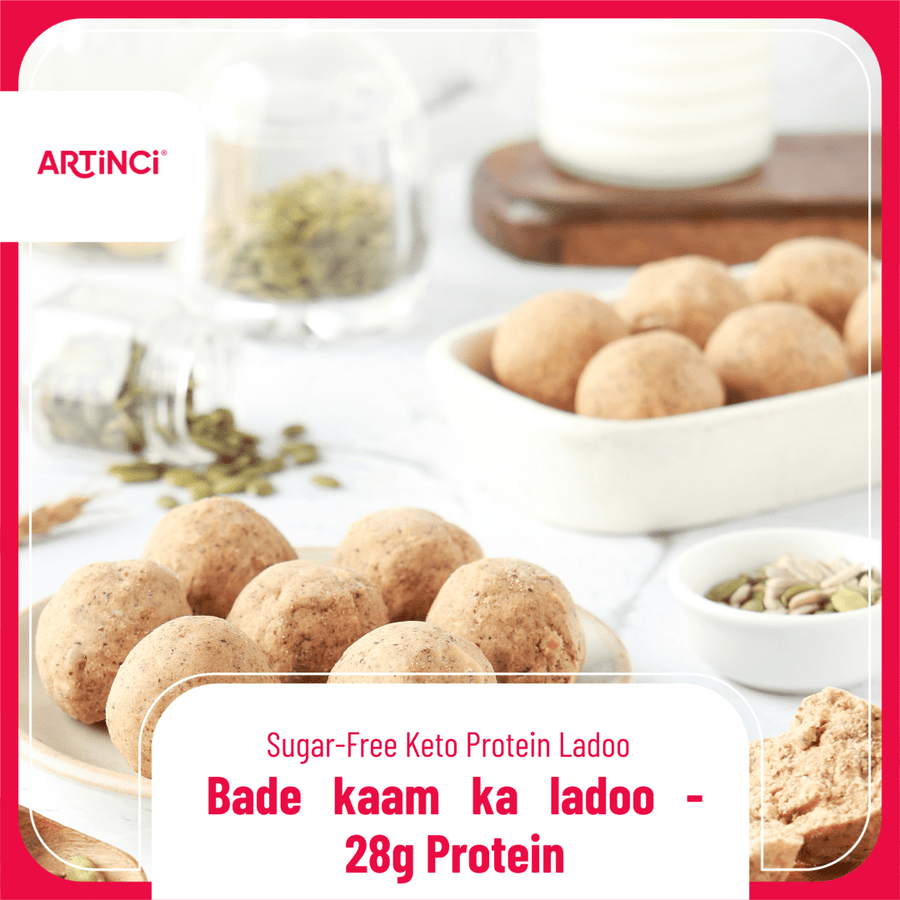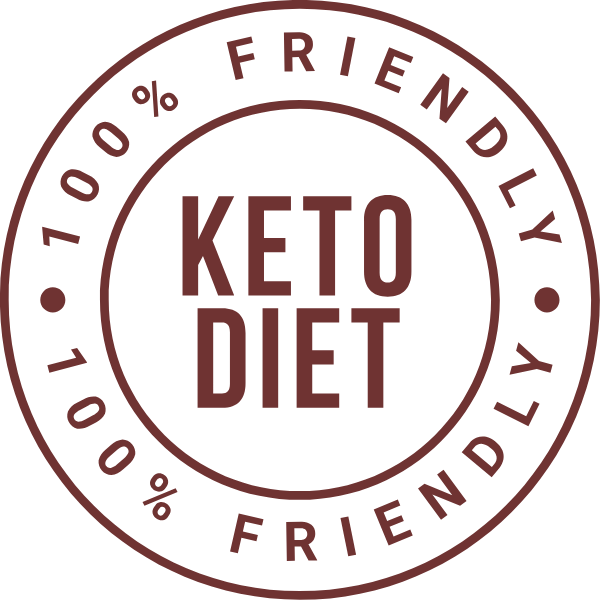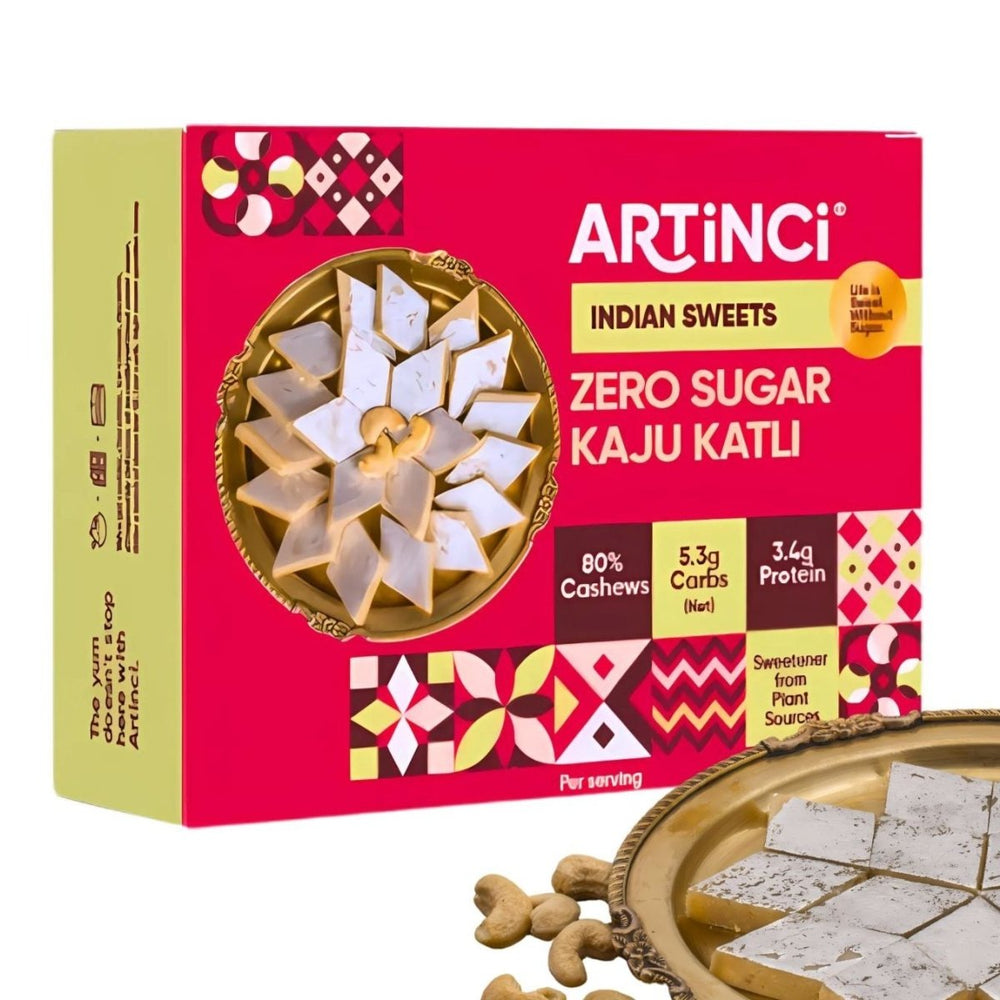Welcome to the world of sugar free joy!
Low Carb Sugar-Free Desserts & Snacks
Artinci was born out of Aarti's and Sumit's (Artinci's founders) abiding love for great-tasting dessert, while helping them stay committed to their health goals as well. As a result, Artinci makes delicious desserts with zero sugar, that are science and evidence-backed.
Aarti and Sumit come from a family of three generations of diabetics. They were themselves diagnosed pre-diabetic in 2012, and right there began a lifelong quest of a healthy, active lifestyle, including healthy swaps in food
Indulgent Halwas & Cozy Cakes



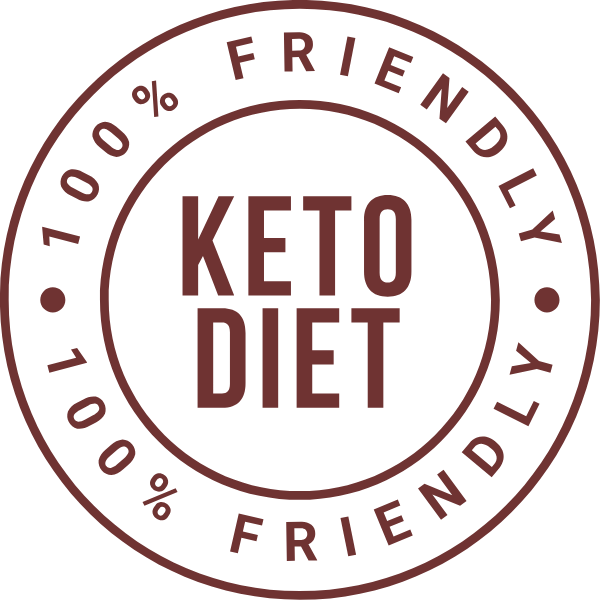

Berries Almond Cake - Sugar-Free, Keto, Gluten-Free, Diabetic-friendly (contains egg)


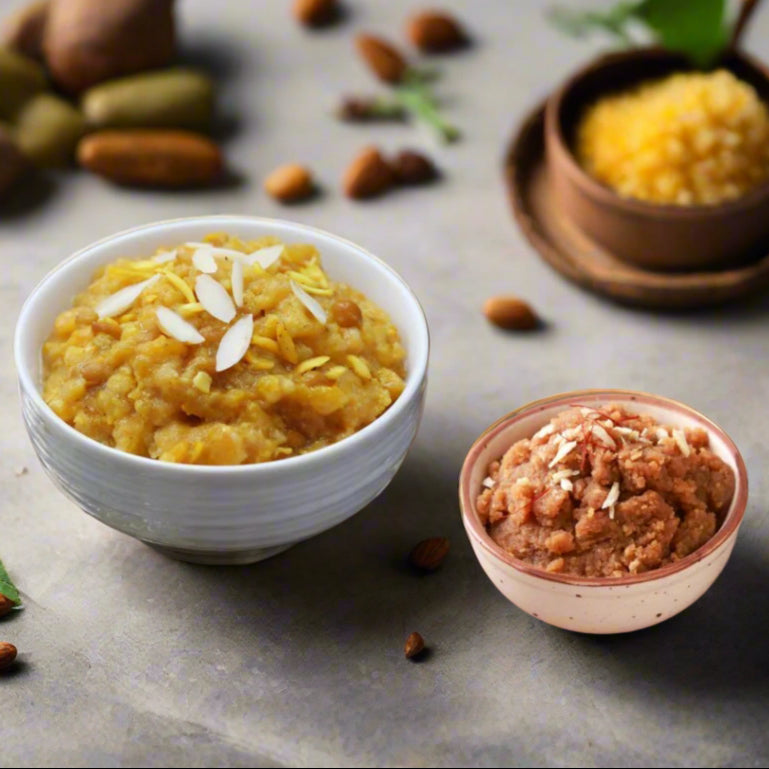
Sugar free Halwa combo @499



Aarti Laxman (Founder)
Artinci is founded by Aarti Laxman, a certified Metabolic coach in the Low-Carb Nutrition & Metabolic Health domain from dLife.in, India’s only legally tenable course in this subject—recognized by the NSDC (under the Ministry of Skill Development & Entrepreneurship, Govt. of India). It’s also internationally accredited by the CPD Standards Office UK, with a global record of 144 CPD hours—the highest for any course of its kind. The accreditation is both nationally valid and globally recognised in over 50+ countries..
Festive Gifting in Artinci
Let customers speak for us
All about Sugar and sugar-free

Healthy eating isn't about strict diets or depriving yourself of foods you love. It's a sustainable approach to nourishing your body with the right balance of nutrients for optimal health and well-being.A healthy diet supports your immune system, maintains steady energy levels, and reduces the risk of chronic diseases. It can improve mental clarity, enhance mood, and help you maintain a healthy weight.The 5 secrets to healthy eating we'll explore are: Choosing high-fiber starchy carbohydrates Incorporating colorful fruits and vegetables Adding fish to your weekly menu Reducing sugary drinks and added sugars Preparing meals at home with whole foods These proven strategies will transform your relationship with food and set you on a path to better health.However, it's important to remember that healthy eating doesn't mean you have to completely eliminate treats from your diet. For instance, indulging in Kaju Katli or Almond cookies can be part of a balanced diet if consumed in moderation. These sweets can even be made healthier, such as opting for sugar-free versions which are diabetic-friendly and keto-friendly.Let's dive into each secret and discover how you can implement them in your daily life while still enjoying the foods you love.Secret 1: Base Your Meals on Higher Fiber Starchy CarbohydratesHigh fiber starchy carbohydrates serve as the foundation of a balanced diet, providing essential energy and nutrients your body needs. These complex carbohydrates break down slowly in your digestive system, delivering steady energy levels throughout the day.Key whole grain options include: Brown rice Quinoa Whole wheat bread and pasta Steel-cut oats Barley Sweet potatoes The fiber content in these foods plays a crucial role in your digestive health. A single serving of brown rice (1 cup) contains about 3.5 grams of fiber, while a cup of steel-cut oats provides 8 grams. Fiber supports regular bowel movements and feeds beneficial gut bacteria, making it essential for overall health.Your body benefits from high-fiber carbohydrates in multiple ways: Blood sugar control: The slow digestion process helps maintain stable blood sugar levels Digestive health: Fiber supports regular bowel movements and feeds beneficial gut bacteria Weight management: These foods help you feel full longer, reducing unnecessary snacking Heart health: Soluble fiber helps lower cholesterol levels Making the switch to whole grain alternatives is simple. Replace white rice with brown rice, choose whole wheat bread instead of white bread, and start your day with steel-cut oats. These small changes can significantly impact your nutritional intake and energy levels.While incorporating these starchy carbohydrates into your meals, it's also important to consider the type of sweeteners you use. For instance, erythritol, a popular sugar substitute, has its own set of benefits and risks that are worth understanding. Alternatively, some may wonder if jaggery could be a good alternative sweetener for diabetics; this is a question that merits exploration as well.Incorporating more fiber into your diet can greatly enhance your overall health.Secret 2: Eat Plenty of Fruits and Vegetables DailyYour plate should be filled with a variety of colorful fruits and vegetables. Each color represents different nutrients your body needs to thrive.Here's what fruits and vegetables bring to your health: Natural Disease Fighters: Antioxidants in fruits and vegetables protect your cells from damage and reduce inflammation Brain Power Boost: B-vitamins and other nutrients support cognitive function and mental clarity Immune System Support: Vitamin C from citrus fruits and leafy greens strengthens your body's defense system Digestive Health: The fiber content aids digestion and maintains gut health Quick Tips for Adding More Produce: Add berries to your breakfast Pack cut vegetables for snacks Include a salad with lunch and dinner Blend fruits into smoothies Replace pasta with spiralized vegetables Recommended Daily Portions: 2-3 cups of vegetables 1.5-2 cups of fruits Fresh, frozen, or canned - all forms count toward your daily intake. Choose frozen fruits without added sugars and canned vegetables with no added salt for the best nutritional value.Raw vegetables provide maximum nutrients, but gentle cooking methods like steaming or roasting can make some nutrients more accessible to your body.While focusing on a healthy diet is essential, it's equally important to consider the environmental impact of our food choices. For instance, Artinci is committed to reducing the carbon footprint associated with e-commerce deliveries by supporting companies that remove carbon from the atmosphere. This means you can enjoy your fresh produce while also contributing to a healthier planet.Secret 3: Include More Fish in Your DietAdding fish to your weekly meal plan creates a powerful boost to your nutritional intake. Health experts recommend eating at least one portion of fish per week, with specific emphasis on oily fish varieties.Top Oily Fish Choices: Salmon Mackerel Sardines Trout Herring These fish varieties pack a substantial amount of omega-3 fatty acids - essential nutrients your body can't produce on its own. A 140g portion of oily fish delivers your weekly recommended dose of these beneficial compounds.The omega-3s found in fish support: Brain function Heart health Joint flexibility Reduced inflammation Better skin condition However, for those who are pregnant and managing dietary changes like gestational diabetes, incorporating fish into the diet can be particularly beneficial.Canned options work just as well if you can't access fresh fish. Choose varieties packed in water rather than oil to maximize health benefits.Quick Serving Ideas: Grilled salmon with lemon and herbs Mackerel fish cakes Sardines on whole-grain toast Trout baked in foil with vegetables Herring in a fresh salad For those following a plant-based diet, seaweed and algae provide alternative sources of omega-3s. Supplements can also help bridge nutritional gaps, though whole food sources remain the optimal choice.Remember to vary your fish choices - this helps you obtain different nutrients while minimizing exposure to any environmental contaminants that might be present in certain fish species.Secret 4: Limit Sugary Drinks and Reduce Added SugarsThe average American consumes 88 grams of added sugar daily - that's 22 teaspoons and more than triple the recommended amount. Sugary drinks represent the largest source of these added sugars, contributing to: Weight gain and obesity Type 2 diabetes Heart disease Tooth decay Liver problems Nutrient deficiencies A single 12-ounce can of soda contains about 39 grams of sugar - equivalent to 10 sugar cubes. Your body processes these liquid calories differently than solid food, leading to increased hunger and overeating.Replace sugary beverages with these healthier alternatives: Water infused with fresh fruits Unsweetened tea (hot or iced) Sparkling water with a splash of 100% fruit juice Coconut water Homemade smoothies without added sugars Hidden sugars lurk in many beverages marketed as "healthy." Check labels for these sugar aliases: High fructose corn syrup Dextrose Maltose Cane juice Fruit juice concentrate Track your daily sugar intake using a food diary app. Set realistic reduction goals - start by cutting one sugary drink per day. Your taste buds will gradually adapt to less sweetness, making water and unsweetened beverages more appealing.Secret 5: Prepare Meals at Home Using Whole or Minimally Processed FoodsHome cooking puts you in control of your nutrition. When you prepare meals in your kitchen, you decide exactly what ingredients go into your food - from the amount of salt to the quality of oils used.Benefits of Home-Cooked Meals: Direct control over portion sizes Selection of fresh, high-quality ingredients Reduced exposure to hidden additives Cost-effective compared to eating out Opportunity to develop cooking skills Understanding the difference between whole and processed foods empowers you to make better choices. Whole foods remain in their natural state or undergo minimal processing - think fresh vegetables, fruits, whole grains, and lean meats. Processed foods often contain added sugars, preservatives, and artificial ingredients that can diminish their nutritional value.Quick Tips for Incorporating Whole Foods: Start with simple recipes using 5-7 ingredients Stock your pantry with whole grain staples Buy fresh produce in season Prep ingredients in advance for quick assembly Keep frozen vegetables on hand for convenience The quality of your ingredients directly impacts the nutritional value of your meals. Choosing minimally processed foods helps maintain essential nutrients, fiber, and natural compounds that support your health. Your body recognizes and processes these natural ingredients more efficiently than their heavily processed counterparts.To make home cooking easier and more enjoyable, consider using some Artinci Home Chef products. These DIY products can help you prepare delicious meals tailored to your cravings while still focusing on whole or minimally processed foods.Additional Tips to Support Healthy Eating PracticesMeal Planning for SuccessPlanning your meals in advance creates a structured approach to healthy eating. Set aside time each weekend to map out your meals for the upcoming week. Create a detailed shopping list based on your meal plan to avoid impulse purchases and ensure you have all necessary ingredients on hand.Smart Portion Control Strategies Use smaller plates and bowls to naturally reduce serving sizes Fill half your plate with vegetables Measure portions using your hand as a guide: Palm size for protein Fist size for carbohydrates Thumb size for fats Hydration Guidelines Start each day with a glass of water Keep a reusable water bottle within reach Set reminders to drink water throughout the day Track your daily intake using a water tracking app Salt Moderation Tips Replace salt with herbs and spices Rinse canned vegetables before use Taste food before adding salt Choose low-sodium alternatives Creating a weekly meal prep routine helps maintain healthy eating habits. Dedicate 2-3 hours to preparing ingredients, cooking base meals, and portioning snacks. Store prepared meals in clear containers at eye level in your refrigerator to make healthy choices easily accessible.ConclusionSustainable healthy eating habits create a foundation for lifelong wellness. The five secrets shared here - from choosing fiber-rich carbohydrates to preparing home-cooked meals - work together to protect your body against diseases and boost your daily energy levels.You don't need to transform your diet overnight. Start with one small change: Switch white bread to whole grain Add an extra serving of vegetables to your dinner Replace one sugary drink with water Each positive choice builds momentum toward better health. Your future self will thank you for the steps you take today to nourish your body with wholesome, nutrient-rich foods.Ready to begin your healthy eating journey? Pick one habit and start now.FAQs (Frequently Asked Questions)What are the key components of practicing healthy eating?Practicing healthy eating involves basing meals on higher fiber starchy carbohydrates like whole grains, eating plenty of fruits and vegetables daily, including more fish rich in omega-3 fatty acids, limiting sugary drinks and added sugars, and preparing meals at home using whole or minimally processed foods.Why should I base my meals on higher fiber starchy carbohydrates?Higher fiber starchy carbohydrates such as brown rice, whole wheat bread, and oats provide sustained energy, essential nutrients, and support digestive health. They form a balanced diet foundation by supplying complex carbs and fiber that help maintain steady blood sugar levels.How can incorporating more fruits and vegetables benefit my health?Eating a variety of colorful fruits and vegetables daily supplies vital vitamins, minerals, and antioxidants that support overall health. These nutrients help boost the immune system, reduce inflammation, and protect against chronic diseases.What is the recommended frequency for including fish in a healthy diet?It is recommended to consume at least one portion of fish per week, focusing on oily fish like salmon and mackerel. These fish are rich in omega-3 fatty acids which promote heart health and support brain function.Why should I limit sugary drinks and added sugars in my diet?Excessive consumption of sugary drinks and added sugars can lead to weight gain, increased risk of chronic diseases such as diabetes, and negatively impact overall health. Choosing healthier alternatives like water or unsweetened beverages helps manage weight and supports better health outcomes.How does preparing meals at home with whole or minimally processed foods improve nutrition?Cooking meals at home allows you to control ingredients, reduce intake of unhealthy additives, and choose nutrient-dense whole or minimally processed foods. This practice enhances the quality of your diet by promoting healthier choices and supporting sustainable eating habits.

Did You Know There Are 5 Major Diet Groups?
Understanding the five major diet groups is essential for maintaining a balanced, healthy lifestyle. These fundamental categories - fruits, vegetables, grains, protein foods, and dairy - serve as building blocks for optimal nutrition.Each group plays a unique role in supporting your body's functions: Fruits deliver essential vitamins and natural sugars Vegetables provide crucial minerals and fiber Grains supply sustained energy through complex carbohydrates Protein foods support muscle growth and repair Dairy products strengthen bones with calcium and vitamin D Following dietary guidelines based on these five groups helps prevent nutrient deficiencies and reduces the risk of chronic diseases. By incorporating foods from each category into your daily meals, you create a foundation for sustained health and well-being.Think of these diet groups as puzzle pieces - when combined correctly, they create a complete picture of balanced nutrition. Your food choices within these groups can be personalized to match your preferences while maintaining the essential principles of healthy eating.For instance, if you're looking to manage specific health conditions such as gestational diabetes, understanding these diet groups can provide valuable guidance. Additionally, it's important to consider sustainable practices in our food consumption. This includes being mindful of the climate impact associated with eCommerce deliveries.Moreover, exploring diverse culinary options within these diet groups can also enhance your eating experience. For example, trying out traditional Indian sweets like Kaju Katli or Motichoor Ladoo could add a delightful twist to your diet while still adhering to the nutritional guidelines of the five major diet groups.The Five Major Diet Groups You Should Know AboutYour daily food choices directly impact your health and well-being. Understanding these five essential diet groups helps you make informed decisions about your nutrition.1. FruitsNature's sweet treats pack a powerful nutritional punch. Fresh fruits deliver essential vitamins and minerals your body needs to function at its best. Here's what makes fruits a vital part of your diet: Vitamin C in citrus fruits strengthens your immune system Potassium in bananas supports heart health Antioxidants in berries protect cells from damage Natural fiber aids digestion and maintains healthy blood sugar levels The natural sugars in fruits provide quick energy while their fiber content helps you feel full longer. Adding fruits to your breakfast, using them as snacks, or incorporating them into desserts creates delicious ways to boost your nutrient intake.Fresh vs ProcessedDifferent forms of fruit offer varying nutritional benefits: Raw fruits provide maximum nutrient content Frozen fruits maintain most nutrients and offer convenience Dried fruits contain concentrated nutrients but higher sugar content Canned fruits serve as practical alternatives when fresh isn't available Daily Fruit Recommendations Eat 2-4 servings of fruit per day Choose different colored fruits for diverse nutrients Include whole fruits rather than juices Mix seasonal fruits for variety and cost-effectiveness It's important to note that the natural fiber found in fruits not only aids digestion but also plays a crucial role in maintaining healthy blood sugar levels, making it particularly beneficial for those managing diabetes.2. VegetablesVegetables are incredibly nutritious and come in different types, each with its own health benefits:1. Dark Leafy Greens Examples: Spinach, kale, collard greens Nutrients: Iron, calcium, vitamins A, C, K Benefits: Supports bone health and immune function 2. Cruciferous Vegetables Examples: Broccoli, cauliflower, brussels sprouts Nutrients: Antioxidants, anti-inflammatory compounds Benefits: Aids in detoxification and cancer prevention 3. Root Vegetables Examples: Carrots, sweet potatoes, beets Nutrients: Beta-carotene, fiber Benefits: Promotes eye health and digestive wellness You can easily increase your vegetable intake by trying out these creative preparation methods: Blend spinach or kale into fruit smoothies Add shredded carrots to morning oatmeal Roast mixed vegetables with olive oil and herbs Create colorful stir-fries with seasonal produce Prepare veggie-based soups and stews Use lettuce wraps instead of bread Spiralize zucchini as a pasta alternative The USDA recommends consuming 2-3 cups of vegetables daily. To maximize nutritional benefits, make sure to vary your choices across all subgroups.3. GrainsWhole grains are nutritional powerhouses in your daily diet. Unlike refined grains, which have had their bran and germ layers removed during processing, whole grains retain these layers, making them a rich source of essential nutrients. In fact, whole grains offer a multitude of health benefits: They help maintain steady blood sugar levels. They promote digestive health. They provide sustained energy release. They are high in fiber content. They contain essential B vitamins. Popular whole grain options include: Ancient grains: Quinoa, amaranth, millet Traditional choices: Brown rice, oats, barley Bread varieties: 100% whole wheat, rye, sprouted grain Pasta alternatives: Whole wheat pasta, buckwheat noodles The recommended daily intake is 6-8 servings of grains, with at least half coming from whole grain sources. To ensure you're choosing the right products, read food labels and look for "whole grain" as the first ingredient.4. Protein FoodsProtein is essential for your body to function properly. It plays a crucial role in repairing and building muscles, especially after exercise. Additionally, protein supports your immune system and helps keep your skin, hair, and nails healthy.Animal-Based Protein Sources: Lean chicken breast (31g protein per 100g) Fish like salmon and tuna (20-25g protein per 100g) Eggs (6g protein per large egg) Turkey (29g protein per 100g) Plant-Based Protein Sources: Tofu (8g protein per 100g) Lentils (9g protein per 100g) Chickpeas (15g protein per 100g) Quinoa (4g protein per 100g) Almonds (21g protein per 100g) Your daily protein needs depend on factors such as age, weight, and activity level. As a general guideline, aim for 0.8 grams of protein per kilogram of body weight. If you're an athlete or highly active individual, you may require more protein to support muscle recovery and growth.To ensure you're getting all the essential amino acids your body needs, it's important to combine different protein sources. For example, if you're following a plant-based diet, pairing foods like rice with beans or hummus with whole grain pita can help you achieve optimal protein intake.5. Dairy or Dairy AlternativesDairy products are packed with nutrients, especially calcium, which is crucial for strong bones and teeth. One cup of milk can give you about 30% of the calcium you need in a day. But dairy foods offer more than just calcium: Vitamin D to help your body absorb calcium Protein to keep your muscles healthy Potassium for a healthy heart B12 for proper nerve function Can't consume dairy? You have options:Plant-based alternatives deliver similar nutritional benefits: Almond milk - low in calories, high in vitamin E Soy milk - protein-rich with heart-healthy compounds Oat milk - excellent source of fiber and B vitamins Coconut yogurt - contains beneficial probiotics Cashew cheese - creamy texture with healthy fats Many dairy alternatives come fortified with calcium and vitamin D to match traditional dairy benefits. When selecting alternatives, check nutrition labels for added sugars and opt for unsweetened versions where possible. Rotating between different alternatives helps ensure you receive a diverse range of nutrients.If you're looking to sweeten your dishes while avoiding dairy, consider using jaggery as a natural alternative. It's a healthier sweetener option that can be especially beneficial for diabetics.Additionally, if you're interested in exploring more about the variety of Indian sweets that can cater to different dietary needs, including sugar-free options suitable for keto diets, our Kaju Katli and almond cookies combo might be worth trying.For those who enjoy cooking, our Artinci Home Chef range offers DIY products that can help satisfy your cravings while adhering to your dietary preferences.Benefits Of Following A Balanced Diet Based On The Five Major Diet GroupsThe five major diet groups are the foundation of dietary guidelines worldwide, supported by extensive scientific research and nutritional expertise. These guidelines provide a framework for balanced meals that supply essential nutrients your body requires for optimal functioning.A diet abundant in foods from each group offers: Disease Prevention: Regular intake of nutrient-rich foods lowers your risk of heart disease, type 2 diabetes, and certain cancers Enhanced Immune Function: The combination of vitamins, minerals, and antioxidants boosts your body's natural defense systems Stable Blood Sugar: The blend of complex carbohydrates, proteins, and healthy fats helps maintain steady glucose levels Better Digestive Health: Fiber from fruits, vegetables, and whole grains promotes a healthy gut microbiome Research indicates that individuals who adhere to balanced eating patterns based on these food groups experience: Sustained energy throughout the day Improved mental clarity and focus Better weight management Enhanced athletic performance Quality sleep patterns Reduced inflammation Your body operates optimally when it receives the right balance of nutrients. The five diet groups work together - proteins repair tissue, carbohydrates provide energy, fruits and vegetables deliver antioxidants, while dairy supplies calcium for bone strength. This interconnected system of nutrition establishes a foundation for lifelong health and vitality.Including alternatives like erythritol instead of traditional sugars can also be advantageous. This sugar-free substitute can help maintain stable blood sugar levels while still allowing you to savor sweet flavors.ConclusionYour journey to optimal health begins with including foods from all five major diet groups. The beauty of this approach is its flexibility - you can customize it to fit your personal preferences while still maintaining a balanced diet.Key takeaways for your healthy eating journey: Mix colorful fruits and vegetables into your daily meals Choose whole grains for sustained energy Include diverse protein sources that suit your lifestyle Select dairy or alternatives that work for your body Remember: There's no one-size-fits-all approach to healthy eating. The five diet groups are your foundation - use them as a guide to create eating patterns that nourish your body and bring you joy. Your commitment to incorporating these essential food groups today shapes your health tomorrow.While focusing on a balanced diet, it's also important to treat yourself in moderation. Enjoy some delicious best-selling cakes, cookies, or chocolates from trusted sources like Artinci every now and then. Just remember, moderation is key!

7 Healthy Diets That Will Transform Your Life
Your diet shapes every aspect of your life - from your energy levels to your mental clarity and physical health. A well-chosen eating plan can transform your body, boost your immunity, and enhance your quality of life.We've researched and compiled 7 powerful dietary approaches that have proven track records in helping people achieve their health goals. These diets go beyond simple weight management; they're comprehensive lifestyle systems designed to: Reduce inflammation Balance hormones Improve heart health Boost brain function Support digestive wellness Increase longevity Whether you're looking to manage a specific health condition or simply want to feel your absolute best, you'll find a sustainable eating plan that aligns with your needs and preferences in our carefully curated selection.However, it's important to remember that a diet doesn't always mean deprivation. For instance, indulging in Kaju Katli or enjoying some guilt-free almond cookies can be part of a balanced diet. These treats are not only delicious but also cater to various dietary needs such as being gluten-free or sugar-free.Moreover, during festive seasons, incorporating traditional sweets like the Motichoor Ladoo into your diet can still align with your health goals if chosen wisely.Ultimately, achieving your health goals is about finding the right balance and making informed choices, which is why we strive to provide you with the best resources and options available. Don't hesitate to explore our best-selling products that have been popular among our satisfied customers.1. DASH Diet: Dietary Approaches to Stop HypertensionThe DASH Diet is a scientifically-proven eating plan designed to combat high blood pressure through strategic food choices. This diet has earned recognition from medical professionals for its ability to lower blood pressure levels within weeks of adoption.Daily Serving Guidelines: 6-8 servings of whole grains 4-5 servings of vegetables 4-5 servings of fruits 2-3 servings of low-fat dairy 6 or fewer servings of lean meats 2-3 servings of healthy fats and oils The DASH Diet limits sodium intake to 2,300mg daily, with some variations recommending 1,500mg for enhanced blood pressure management. Research shows this eating pattern can reduce systolic blood pressure by 8-14 points.Beyond blood pressure control, the DASH Diet delivers impressive health benefits: Reduces risk of heart disease Supports healthy weight management Helps prevent diabetes Improves cholesterol levels Strengthens bone health The diet's emphasis on whole foods creates a nutrient-rich eating pattern packed with potassium, calcium, magnesium, and fiber - essential nutrients that work together to maintain cardiovascular health and optimal blood pressure levels.Incorporating [sugar-free substitutes like erythritol](https://www.artinci.com/blogs/news/the-truth-about-sugar-free-substitute-erythritol) into the diet can also be beneficial. Erythritol is a popular sugar alternative that comes with its own set of benefits and risks, making it important to understand before making dietary changes.For those who prefer natural sweeteners, [jaggery](https://www.artinci.com/blogs/news/is-jaggery-a-good-alternative-sweetener-for-diabetics-fact-or-a-myth-lets-find-out) might be a suitable option. However, it's crucial to know whether it's a good alternative for diabetics or not.If you're looking for convenient options to prepare meals that align with the DASH diet, consider exploring products from Artinci Home Chef. They offer a range of DIY products tailored for your cravings.2. Mediterranean Diet: Embracing a Plant-Based Lifestyle for Heart HealthThe Mediterranean Diet draws inspiration from traditional eating patterns of countries bordering the Mediterranean Sea. This heart-healthy approach prioritizes: Fresh fruits and vegetables at every meal Whole grains and legumes as dietary staples Extra virgin olive oil as the primary fat source Nuts and seeds for healthy snacking Fish and seafood at least twice a week Research published in the New England Journal of Medicine demonstrates a 30% reduction in cardiovascular events among Mediterranean Diet followers. The diet's anti-inflammatory properties help protect against: Heart disease Type 2 diabetes Certain cancers Cognitive decline You'll find the Mediterranean Diet rich in antioxidants, fiber, and healthy fats. The eating pattern encourages social dining and mindful eating practices - sharing meals with family and friends while savoring each bite. This sustainable approach allows for occasional red wine consumption and treats, making it adaptable to various lifestyles and cultural preferences.3. American Heart Association Diet Recommendations: Promoting Cardiovascular Health Through NutritionThe American Heart Association (AHA) sets gold-standard dietary guidelines focused on preventing cardiovascular disease through mindful eating. These recommendations emphasize a balanced approach to nutrition that supports long-term heart health.Key AHA Diet Guidelines: Consume 8-10 servings of fruits and vegetables daily Choose fiber-rich whole grains over refined options Select lean proteins like fish, poultry, and plant-based alternatives Include healthy fats from sources like avocados and olive oil Limit sodium intake to less than 2,300mg per day Reduce added sugars to less than 6 teaspoons for women, 9 for men The AHA diet stands out by recommending specific portion sizes and daily limits. You'll find clear guidance on reducing processed foods while incorporating heart-protective nutrients into your meals. This approach has shown significant benefits in lowering blood pressure, managing cholesterol levels, and reducing inflammation markers linked to heart disease.Research supports the effectiveness of AHA recommendations, with studies showing up to 80% reduction in heart disease risk when following these guidelines consistently. The diet works by combining proven nutritional strategies with practical, sustainable eating habits you can maintain long-term.In addition to these dietary changes, it's also essential to consider the environmental impact of our food choices. Adopting a sustainable lifestyle can be beneficial not just for our health but also for the planet. For instance, Artinci's climate commitment highlights the importance of supporting businesses that prioritize eco-friendly practices such as carbon-neutral shipping. By making conscious choices about our consumption and supporting such initiatives, we can contribute to a healthier planet while also promoting our own cardiovascular health through the AHA's recommended diet.4. Flexitarian Diet: A Flexible Approach to Plant-Based Eating for Weight ManagementThe Flexitarian Diet combines the words "flexible" and "vegetarian" to create a balanced eating approach that prioritizes plant-based foods while allowing occasional meat consumption. This diet doesn't require strict rules or complete elimination of animal products, making it an accessible option for those seeking sustainable weight management.Key Components of the Flexitarian Diet: Plant proteins (beans, lentils, tofu) Whole grains Fresh fruits and vegetables Nuts and seeds Limited portions of meat, fish, or poultry The diet's flexibility helps you maintain a healthy weight by: Reducing calorie intake through plant-based meals Increasing fiber consumption for better satiety Supporting metabolic health with nutrient-dense foods Allowing social eating without strict restrictions Research shows that flexitarians typically weigh 15% less than non-vegetarians. The diet's emphasis on whole, minimally processed foods naturally reduces calorie intake while providing essential nutrients. You can customize your meat consumption based on your preferences - from occasional meat-free days to primarily plant-based eating with monthly meat servings.5. Paleo Diet: Eating Like Our Ancestors for Optimal HealthThe Paleo Diet is inspired by our hunter-gatherer ancestors and emphasizes whole, unprocessed foods that were consumed during the Paleolithic era. This eating plan excludes modern processed foods, grains, dairy, and refined sugars.Foods to Embrace on Paleo: Grass-fed meats and wild-caught fish Fresh fruits and vegetables Nuts and seeds Healthy fats (coconut oil, olive oil, avocados) Eggs from pasture-raised poultry Foods to Avoid: Processed foods and refined sugars Grains and legumes Dairy products Artificial sweeteners Industrial vegetable oils Research suggests that the Paleo Diet can improve various aspects of health. Many followers report better digestion, consistent energy levels throughout the day, and improved sleep quality. The high protein content of the diet helps maintain muscle mass, while the emphasis on vegetables provides essential nutrients and fiber.The removal of processed foods and refined sugars may lead to reduced inflammation in the body, which could benefit those with autoimmune conditions. Additionally, the focus on nutrient-dense foods supports optimal brain function and may lower the risk of chronic diseases.6. Plant-Based Diet: Nourishing Your Body with Nature's BountyA plant-based diet centers on foods derived from plants, including vegetables, fruits, whole grains, legumes, nuts, and seeds. This eating pattern minimizes or eliminates animal products, making it an excellent choice for both health-conscious individuals and environmental advocates.The nutritional profile of plant-based foods is remarkable: Vitamins & Minerals: Rich in essential nutrients like vitamin C, E, and K Fiber: High dietary fiber content supports digestive health and can even play a role in supporting diabetes control during Ramadan, making it a valuable addition to any diet. Antioxidants: Contains disease-fighting compounds like flavonoids and carotenoids Healthy Fats: Abundant in omega-3 fatty acids from sources like flaxseeds and walnuts You can meet your protein requirements through: Legumes (lentils, chickpeas, beans) Quinoa and other whole grains Tofu and tempeh Nuts and seeds Research shows plant-based diets can reduce the risk of heart disease, certain cancers, and type 2 diabetes. They also support healthy weight management and provide sustained energy throughout the day.The key to success lies in proper planning and ensuring a diverse range of plant foods to meet all nutritional needs. Many athletes and fitness enthusiasts now embrace plant-based eating for its performance-enhancing benefits and quick recovery support.7. Whole30 Program: Resetting Your Relationship with Food Through an Elimination ProtocolThe Whole30 Program offers a structured approach to identifying problematic foods through a 30-day elimination phase. During this period, participants remove specific food groups from their diet: Dairy products Added sugars and artificial sweeteners Grains Legumes Alcohol This reset allows your body to heal from potential food sensitivities while breaking unhealthy eating patterns. The program emphasizes consuming whole, nutrient-dense foods: High-quality proteins (eggs, meat, seafood) Vegetables Fruits Healthy fats (avocados, nuts, olive oil) After the elimination phase, foods are systematically reintroduced to identify which ones might trigger digestive issues, inflammation, or unwanted cravings. This methodical approach helps participants develop a deeper understanding of their body's response to different foods.Common Principles Among Healthy Diets That Promote Long-Term Lifestyle ChangesDespite their unique approaches, these healthy diets share essential principles that drive sustainable lifestyle changes: Whole Foods Priority: Each diet emphasizes minimally processed, natural ingredients over packaged alternatives Plant-Based Foundation: Vegetables, fruits, and legumes form the cornerstone of these eating patterns Mindful Protein Selection: Lean proteins, particularly fish and plant-based options, are preferred Sugar Reduction: All diets recommend limiting added sugars and refined carbohydrates Physical Activity Integration: Regular exercise complements these dietary approaches Portion Awareness: Understanding appropriate serving sizes helps maintain balanced nutrition Hydration Focus: Water consumption is prioritized over sugary beverages Meal Planning: Structured meal preparation supports consistent healthy eating habits These shared elements create a framework for sustainable health improvements, regardless of the specific diet you choose.ConclusionYour journey to better health starts with choosing a diet that aligns with your lifestyle, preferences, and health goals. The DASH, Mediterranean, AHA, Flexitarian, Paleo, Plant-Based, and Whole30 diets each offer unique approaches to nourishing your body.For some, like those managing gestational diabetes during pregnancy, selecting the right diet becomes even more crucial.Remember: sustainable changes create lasting results. Select a diet that you can maintain long-term rather than following strict rules that might lead to frustration. Start small - incorporate elements from these diets gradually into your daily routine.The best diet is one you can stick to consistently. Listen to your body, adjust as needed, and celebrate the positive changes you experience along the way. Your transformation to a healthier lifestyle begins with the choices you make today.

10 Effective Tips to Balance Your Sugar Levels
Maintaining balanced blood sugar levels is crucial for your health and well-being. Your body relies on stable glucose levels to function properly, from powering your brain to energizing your muscles. When these levels become unbalanced, you face serious health risks: Heart disease and cardiovascular complications Kidney damage and potential organ failure Vision problems and nerve damage Increased risk of stroke Compromised immune system function This guide reveals 10 practical strategies to help you maintain healthy blood sugar levels naturally. You'll discover effective exercise routines, dietary choices, and lifestyle adjustments that work together to keep your glucose levels in check. These evidence-based tips are designed to fit into your daily routine, helping you take control of your health and prevent sugar-related complications.One such dietary adjustment could involve exploring sugar-free options that can satisfy your cravings without jeopardizing your health. For instance, Artinci offers a range of sugar-free diabetic friendly sweets which can be a delicious part of your diet while keeping your blood sugar levels in check.Additionally, it's important to remember that maintaining a healthy lifestyle is not just about diet and exercise; it also involves making informed choices about the products we consume. Understanding the delivery policies of the brands we choose can also enhance our shopping experience.Finally, hearing from others who have successfully managed their blood sugar levels can provide motivation and inspiration. Reading about the experiences of happy customers who have benefited from these strategies can serve as a powerful reminder that change is possible with the right approach.Understanding Blood Sugar and Its ImpactBlood sugar, or glucose, is the main source of energy for your body. It travels through your bloodstream, providing fuel to your cells and keeping your bodily functions running smoothly. The pancreas is responsible for controlling these glucose levels by releasing insulin, a hormone that helps cells take in and use sugar efficiently.Causes of High Blood Sugar: Eating too much sugary foods and beverages Not getting enough exercise Dealing with chronic stress Having poor sleep habits Taking certain medications Having underlying health issues It's important to understand that not all sugars are the same. For example, while regular sugar can cause high blood sugar levels, erythritol, a sugar-free alternative, may not have the same impact. However, it's essential to learn about its advantages and disadvantages before making any changes to your diet.Additionally, some people view jaggery as a suitable sweetener for diabetics. But is this really a good choice? The answer might surprise you.Triggers of Low Blood Sugar: Skipping or postponing meals Engaging in intense exercise without proper nutrition Hormonal imbalances Certain diabetes medications Drinking excessive amounts of alcohol When blood sugar levels are imbalanced, it can have a chain reaction throughout your body. High levels can damage blood vessels, leading to potential heart problems, kidney dysfunction, and vision issues. Low levels can cause immediate symptoms like dizziness and confusion, and in severe cases, may even result in seizures.Your nerves are particularly sensitive to changes in sugar levels. Consistently high blood sugar can lead to nerve damage (neuropathy), causing numbness, tingling, or pain - especially in your feet and hands.To manage these fluctuations while still enjoying sweet treats, consider healthier options like Kaju Katli, which is sugar-free and diabetic-friendly, making it the perfect keto-friendly option. Alternatively, our Kaju Katli & Almond cookies combo offers a guilt-free treat that satisfies your sweet tooth without compromising your health.1. Regular Exercise to Boost Sugar MetabolismPhysical activity plays a crucial role in managing blood sugar levels. Your muscles use glucose for energy during exercise, naturally lowering blood sugar levels and improving insulin sensitivity.Cardio Benefits for Blood Sugar ControlIncorporate these cardio exercises into your routine: 30 minutes of brisk walking Swimming or cycling sessions Dancing or aerobic exercises High-intensity interval training (HIIT) Strength Training ImpactInclude these strength training benefits in your regimen: Builds lean muscle mass Increases glucose storage capacity Enhances insulin sensitivity Supports long-term metabolic health The American Diabetes Association recommends 150 minutes of moderate-intensity exercise per week. Break this into manageable 30-minute sessions across 5 days. Combine both cardio and strength training for optimal results - try 3 days of cardio and 2 days of resistance exercises.Pro tip: Start your exercise routine 1-2 hours after eating when blood sugar levels are higher for maximum effectiveness.2. Healthy Diet Choices for Steady Blood SugarYour daily food choices play a crucial role in maintaining balanced blood sugar levels. Making strategic dietary adjustments can help prevent sudden spikes and crashes in your glucose levels.Foods to Reduce or Eliminate: Sugary beverages (sodas, fruit juices, energy drinks) Processed snacks and desserts White bread, pastries, and refined pasta Candy, chocolate bars, and sweetened cereals While it's advisable to reduce processed snacks and desserts, if you ever find yourself craving something sweet, consider opting for healthier alternatives like those available in the best sellers section of certain online stores. These often include options that are lower in sugar and made with healthier ingredients.Smart Carbohydrate Choices: Brown rice Quinoa Steel-cut oats Barley Buckwheat These whole grain options contain complex carbohydrates that break down slowly, providing steady energy release throughout the day. The high fiber content helps slow down glucose absorption, preventing rapid blood sugar fluctuations.Blood Sugar-Friendly Meal Structure: Start with protein (eggs, fish, lean meats) Add non-starchy vegetables (leafy greens, broccoli, cauliflower) Include small portions of whole grains Incorporate healthy fats (avocados, nuts, olive oil) Creating balanced meals with these components helps regulate your blood sugar levels naturally. The combination of protein, fiber, and healthy fats slows down carbohydrate digestion, leading to better glucose control.Remember to read food labels carefully - many "healthy" products contain hidden sugars under different names like dextrose, maltose, or corn syrup.3. Hydration's Role in Sugar RegulationWater is essential for keeping your blood sugar levels in check. When you drink 6-8 ounces of water with your meals, it helps dilute the concentration of sugar in your bloodstream, preventing any sudden spikes after you eat.Key benefits of proper hydration: Helps your kidneys flush out excess glucose through urine Reduces sugar cravings by maintaining satiety Supports liver function in storing and releasing glucose Prevents dehydration-induced elevation of blood sugar levels When you're dehydrated, your body produces a hormone called vasopressin, which can cause your liver to create more glucose and result in higher blood sugar levels. To keep your metabolism functioning optimally and maintain balanced blood sugar levels, make sure to drink water throughout the day, not just during meals.4. Managing Stress to Prevent Sugar SpikesStress triggers the release of cortisol and adrenaline, hormones that directly increase blood sugar levels. Your body responds to both physical and emotional stress by releasing stored glucose into your bloodstream - a survival mechanism that can work against you when stress becomes chronic.This is particularly crucial for pregnant women, as stress management can play a significant role in managing gestational diabetes, a condition that can arise during pregnancy and lead to elevated blood sugar levels.Effective stress-reduction techniques: Practice mindful meditation for 10-15 minutes daily Join gentle yoga classes 2-3 times per week Write in a stress journal to identify triggers Schedule regular counseling sessions Try deep breathing exercises during tense moments Take short walks in nature Listen to calming music or guided relaxations These practices help lower cortisol levels, reducing unnecessary glucose release and supporting balanced blood sugar. Research shows people who practice regular stress management experience better glucose control and fewer blood sugar spikes throughout the day.5. Prioritizing Quality Sleep for Better Insulin SensitivityQuality sleep plays a vital role in regulating your blood sugar levels. Research shows that sleeping 7-8 hours each night helps maintain optimal insulin sensitivity and glucose metabolism.Here's how sleep affects your blood sugar: Your body repairs and regenerates cells during deep sleep phases Growth hormone production peaks during sleep, enhancing insulin function Poor sleep disrupts appetite-regulating hormones, leading to sugar cravings Tips for better sleep quality: Set a consistent sleep schedule Keep your bedroom cool and dark Avoid screens 1-2 hours before bedtime Create a relaxing bedtime routine Skip late-night meals and caffeine Interestingly, maintaining a climate commitment by supporting eco-friendly businesses can also contribute to better overall health, including improved sleep quality. Studies indicate that even one night of poor sleep can reduce insulin sensitivity by up to 25%. Prioritizing restful sleep helps your body maintain stable blood sugar levels naturally.6. Portion Control to Avoid Blood Sugar FluctuationsEating smaller, balanced meals throughout the day helps maintain steady blood sugar levels. Rather than consuming three large meals, try splitting your daily food intake into 4-6 smaller portions spaced 2-3 hours apart.Key portion control strategies: Use smaller plates and bowls to naturally reduce serving sizes Fill half your plate with non-starchy vegetables Limit carbohydrate portions to 1/4 of your plate Include lean protein with each meal This eating pattern prevents dramatic blood sugar spikes and subsequent crashes that often occur after large meals. Your body processes smaller amounts of food more efficiently, leading to better glucose absorption and more consistent energy levels throughout the day.Remember to track your portions using measuring cups or a food scale until you become familiar with appropriate serving sizes. This practice helps develop awareness of proper portion sizes for different food groups.7. Avoiding Tobacco and Limiting Alcohol ConsumptionTobacco use disrupts your body's natural ability to regulate blood sugar levels. Nicotine increases insulin resistance, making it harder for your cells to respond to insulin and process glucose effectively. Smoking can raise blood sugar levels by 30% and increase your risk of developing type 2 diabetes by 40%.Alcohol consumption presents unique challenges for blood sugar management: Drinking on an empty stomach can cause dangerous blood sugar drops Mixed drinks with sugary additives spike glucose levels rapidly Your liver prioritizes processing alcohol over maintaining stable blood sugar Safe alcohol consumption guidelines: Limit drinks to 1 per day for women, 2 for men Always eat a meal when drinking Choose low-sugar options like dry wine or spirits with sugar-free mixers Check your blood sugar before, during, and after drinking 8. Monitoring Blood Sugar Levels Regularly with a GlucometerRegular blood sugar monitoring with a glucometer puts you in control of your health. This small device measures your glucose levels through a tiny drop of blood, providing immediate feedback about how your body responds to different foods and activities.Key benefits of glucose monitoring: Identifies patterns in blood sugar fluctuations Helps you understand how specific foods affect your levels Allows quick adjustments to diet and medication Prevents dangerous high or low sugar episodes Provides data for healthcare providers to optimize treatment Best times to check your levels: First thing in the morning Before meals 2 hours after meals Before and after exercise Before bedtime Keep a detailed log of your readings alongside notes about meals, activities, and medications. This valuable data empowers you to make informed decisions about your diet and lifestyle choices.9. Nutritional Supplements That Support Sugar Balance (with Caution)Specific nutritional supplements can play a vital role in maintaining healthy blood sugar levels. Chromium stands out as a key mineral that enhances insulin's effectiveness, helping your cells absorb glucose more efficiently. You can find chromium in: Broccoli Whole grains Lean meats Egg yolks Magnesium works alongside chromium to support insulin function and glucose metabolism. Rich dietary sources include: Dark leafy greens Nuts and seeds Avocados Black beans Natural supplements like cinnamon have shown promising results in blood sugar regulation. Research suggests that consuming 1-6 grams daily may help reduce fasting blood sugar levels. Apple cider vinegar might improve insulin sensitivity when taken before meals, starting with 1-2 teaspoons diluted in water. Important Safety Note: Always consult your healthcare provider before starting any supplement regimen. Some supplements can interact with medications or cause adverse effects in certain medical conditions.For optimal absorption and effectiveness: Take supplements with meals Start with lower doses Monitor your blood sugar response Choose high-quality, third-party tested products Keep a detailed log of supplement effects on your glucose readings 10. Maintaining a Healthy Weight for Optimal Sugar Control (Sustainable Strategies)A healthy weight directly impacts your blood sugar control. Research shows that losing just 5% of your body weight can significantly improve insulin sensitivity and reduce the risk of type 2 diabetes.Sustainable Weight Management Strategies: Create a calorie deficit of 500-750 calories per day for steady weight loss Track your food intake using a mobile app or journal Weigh yourself weekly at the same time of day Set realistic goals - aim to lose 1-2 pounds per week Smart Food Choices: Fill half your plate with non-starchy vegetables Choose lean proteins like chicken, fish, or legumes Include healthy fats from avocados, nuts, and olive oil Practice mindful eating - chew slowly and stop when satisfied Incorporating more fiber into your diet can also be beneficial. Fiber has surprising benefits for diabetes control, especially during periods like Ramadan when fasting is common.Lifestyle Habits: Get 7-8 hours of sleep nightly Stay active throughout the day Plan meals ahead to avoid impulsive eating Find support through friends, family, or weight management groups Remember: Quick-fix diets rarely work long-term. Focus on building sustainable habits you can maintain. Small, consistent changes lead to lasting results and better blood sugar control.Tip: Work with your healthcare provider to create a personalized weight management plan that considers your medical history and lifestyle needs.








